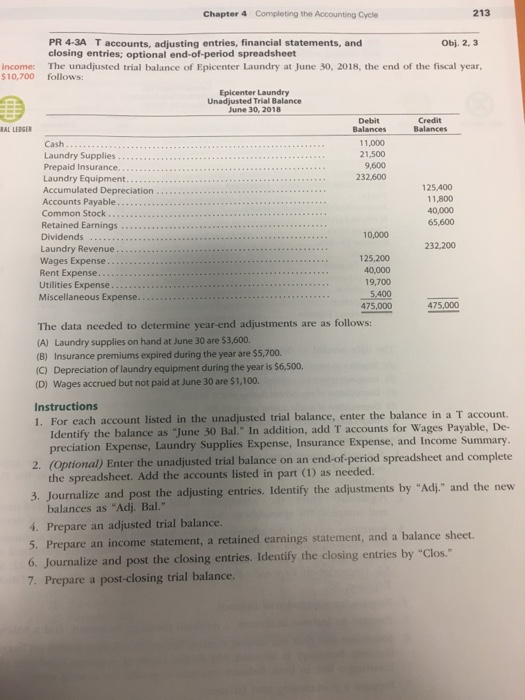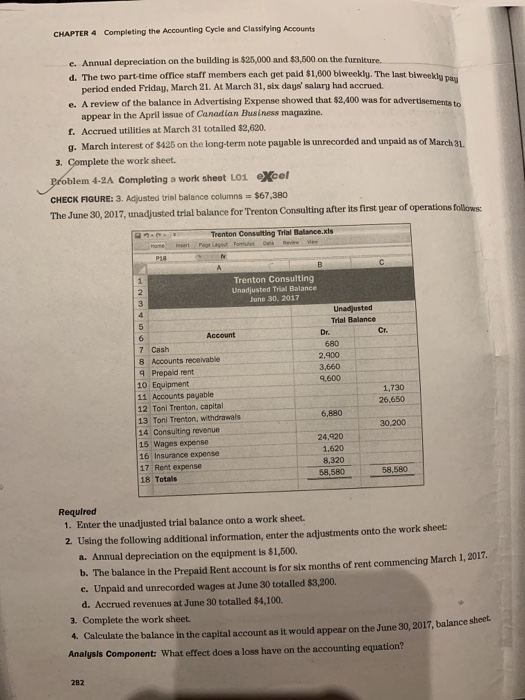
The worksheet is merely a device used to make it easier to prepare adjusting entries and the financial statements. 2 3 Net income.

Chapter 4 Completing the Accounting Cycle.
Chapter 4 completing the accounting cycle answers. CHAPTER 4 Completing the Accounting Cycle ANSWERS TO QUESTIONS 1. A worksheet is not a permanent accounting record. The use of a worksheet is an optional step in the accounting cycle.
The worksheet is merely a device used to make it easier to prepare adjusting entries and the financial statements. Chapter 4–Completing the Accounting Cycle Key 1. After analyzing transactions the next step would be to post the transactions in the ledger.
The most important output of the accounting cycle is the financial statements. The work sheet is not considered a. Chpt 4 11th Ed Chpt 4.
Completing the Accounting Cycle 2 LO 2. Prepare closing entries and post close trial balance CLOSING THE BOOKS CLOSE ZERO OUT TEMPOARY ACCOUNTS SUCH AS REVENUES EXPENSES AND DIVIDENDS. PERMANENT ACCOUNTS BALANCE SHEET ACCOUNTS ARE NOT CLOSED AT THE END OF THE PERIOD AND ARE CARRIED FORWARD FROM YEAR TO YEAR.
4-6 ANSWERS TO QUESTIONS 01. A work sheet is not a permanent accounting record. The use of a work sheet is an optional step in the accounting cycle.
It is simply a convenient and efficient tool for completing some of the steps in the accounting cycle. Formal financial statements are needed because the columnar data are. Chapter 4 completing the accounting cycle learning objectives 1.
Explain the process of closing the books. Describe the content and purpose of a post-closing trial balance. State the required steps in the accounting cycle.
Explain the approaches to preparing cor-recting entries. 4-4 ANSWERS TO QUESTIONS 1. A worksheet is not a permanent accounting record.
The use of a worksheet is an optional step in the accounting cycle. The worksheet is merely a device used to make it easier to prepare adjusting entries and the financial statements. The amount shown in the adjusted trial balance column for an account equals.
Chapter 4 Completing the Accounting Cycle. CourseIntroduction To Accounting 70 122 Chapter 4 C ompleting the A ccou nting Cycle. A balance s heet that places each asset and eac h liability.
Into a specific c ategory. A measure of ho w. 142 Chapter 4 Completing the Accounting Cycle Adjustments Columns The adjustments that we explained and illustrated for NetSolutions in Chapter 3 are entered in the Adjustments columns as shown in Exhibit 3.
Cross-referencing by letters the debit and credit of each adjustment is. Assets and liabilities in the balance sheet will be classified and used to allow decision-makers to evaluate the business. Objectives On completion of this topic you should be able to.
Prepare an accounting work sheet 2. Use the work sheet to complete the accounting cycle 3. Close the revenue expense and drawings accounts 4.
Chapter 4 Power Notes Completing the Accounting Cycle Slide Power Note Topics 3 The Work Sheet 18 Financial Statements 22 The Closing Process 28 Post-Closing Trial Balance 31 Accounting Cycles 43 Working Capital and Current Ratio Note. Solutions Manual Chapter 4 89 SOLUTIONS TO EXERCISES Exercise 4-1 The steps in the accounting cycle are. Analyze transactions by examining source documents.
Journalize transactions in the journal. Post journal entries to the accounts in the ledger. Prepare a trial balance of the accounts and complete the work sheet.
Completion of the Accounting Cycle. After completing this section you will be able to. Analyze business transactions and their effect on the accounting equation.
Journalize and post daily transactions adjusting and closing entries using the double-entry accrual basis accounting system. Chapter 4–Completing the Accounting Cycle Key. After analyzing transactions the next step would be to post the transactions in the ledger.
The most important output of the accounting cycle is the financial statements. The work sheet is not considered. CHAPTER 4 COMPLETING THE ACCOUNTING CYCLE SUMMARY OF QUESTIONS BY STUDY OBJECTIVES AND BLOOMS TAXONOMY Item SO BT Item SO BT Item SO BT Item SO BT Item SO BT True-False Statements 1.
Completing the Accounting Cycle. The accounting cycle starts with the account balances in the ledger at. The beginning of the period.
Name Date SECTION 81 REVIEW QUESTIONS continued 15. SECTION 81 EXERCISESpage 276 Exercise 1 p. 276 Supplies Unadjusted Balance.
Start studying Chapter 4-Completing The Accounting Cycle. Learn vocabulary terms and more with flashcards games and other study tools. Chapter 4 Completing the Accounting Cycle Complete Solution 41 Learning Objective 4-1 1 The balance sheet is the first financial statement that is prepared at the end of the period.
FALSE 2 The statement of retained earnings shows how retained earnings changed during the period due to acquiring. Start studying Chapter 4. Completing the Accounting Cycle.
Learn vocabulary terms and more with flashcards games and other study tools. Accounting QA Library Chapter 4 Completing the Accounting Cycle Obj. 4 5 For the past several years Jeff Horton has operated a part-time consulting business from his which was to be known as Rosebud Consulting on a full-time basis.
Rosebud entered into the V8. PR 4-5B Complete accounting cycle 53775 home. As of April 1 2018 Jeff decided to move to rented quarters and to.
Month as the accounting cycle for Clarks. In the business world the cycle can be any time period but is usually one year. Purpose of adjusting entries.
At this point many ledger accounts are not up to date. In Chapters 3 and 4 we completed these steps of the manual accounting cycle for Clarks Desktop Publishing Services. About Press Copyright Contact us Creators Advertise Developers Terms Privacy Policy Safety How YouTube works Test new features Press Copyright Contact us Creators.
Accounting questions and answers. Chapter 4 Completing the Accounting Cycle 213 PR 4-3A T accounts adjusting entries financial statements and closing entries. Optional end-of-period spreadsheet Obj.
2 3 Net income. The unadjusted trial balance of Epicenter Laundry at June 30 2018 the end of the fiscal year 10700 follows. C H A P T E R Completing the Accounting Cycle 4 Slideshare uses cookies to improve functionality and performance and to provide you with relevant advertising.
If you continue browsing the site you agree to the use of cookies on this website.